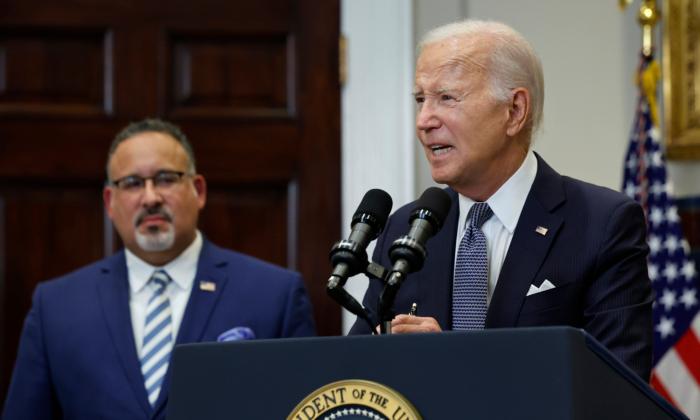The first of roughly 813,000 student loan borrowers will be notified via email on Nov. 28 that their federal loans were forgiven, the White House has announced.
The email, shared ahead of time with The Epoch Times, includes a message for borrowers from President Joe Biden congratulating them on their debt forgiveness and urging them to share their stories of “what this relief means” to them.
“For too long, the student loan program failed to live up to its commitments – and millions like you never got the relief you were owed because of errors and administrative failures,” the missive reads. “I vowed to fix that, and I’m proud that my Administration has delivered on that promise.”
More than 614,000 of the borrowers set to receive the email will have their remaining federal student loan debt entirely wiped out.
Those errors, according to the administration, included the failure to give borrowers proper credit for decades of payments under their income-driven repayment plans and loan servicers’ wrongful placement of certain borrowers in forbearance.
Since then, the Biden administration has sought other ways to deliver on its promise of student loan debt relief.
Earlier this month, the Department of Education revealed that close to 5.5 million borrowers had already enrolled in the plan.
“I’m thrilled to see that in less than three months, nearly 5.5 million Americans in every community across the country are taking advantage of the SAVE Plan’s many benefits, from lower monthly payments to protection from runaway student loan interest.”
Meanwhile, the administration has also forgiven the student loan debt of 662,000 government and nonprofit workers under the Public Service Loan Forgiveness program; 491,000 borrowers with total and permanent disabilities; and nearly 1.3 million borrowers who were cheated by their schools, saw their institutions precipitously close, or were covered under related court settlements.
In all, the administration has approved $127 billion in debt cancelation for nearly 3.6 million borrowers.
Another Way
In addition to those moves, the president has said he still hopes to find an alternative route to providing widespread student debt relief through negotiated rulemaking under the Higher Education Act.The law, passed in 1965, outlines the education secretary’s powers in relation to the modification, waiver, release, or compromise of federal student loans.
Detractors of that plan, however, say that the executive branch does not possess the authority to make such sweeping changes via regulations.
During the public comment portion of the negotiating committee’s Nov. 6 meeting, Cato Institute Center for Educational Freedom Director Neal McCluskey made that very argument.
Mr. McCluskey also expressed disappointment that the committee’s makeup offered no representation for most Americans who have never had federal student loan debt.
“People who attend college are poised to be major economic winners,” he noted. “They should pay the cost of investing in themselves, not taxpayers. They should also bear the risk of an overly expensive or poorly scrutinized investment—that incentivizes thoughtful, efficient education.”
Holding that mass debt cancelation would only incentivize institutions to further drive up the cost of tuition, he contended that the committee’s efforts would only end up hurting those they seek to help.
The committee is set to meet again on Dec. 11-12.







